The Sony BC-ZD1 is a dual-battery USB-C charger for the NP-FZ100 camera battery used in Sony Alpha cameras such as the a7 IV, a7R V, a9 III, a1, a1 II, FX3, FX30, ZV-E10 II, a6700 and many more older models. In short, if you’re an avid Sony shooter, you are likely dealing with this type of battery.
Since the NP-FZ100 battery was introduced in April 2017, the only officially supported way to charge it outside the camera has been with the familiar mains-powered BC-QZ1 charger. This charger was included with many of the above-listed camera models and available as an optional extra purchase for some of the more recent prosumer models that only included a USB power supply capable of charging the battery while it was in the camera.
Now, in 2024, things have finally changed. The new Sony BC-ZD1 is a dual-battery USB-C powered charger, initially available as a separate $119.99 purchase and subsequently included with the brand’s flagship a1 II camera. Over time, I expect the inclusion of the old mains-powered charger to be phased out of inclusion with future Sony cameras from 2025 onwards.
Naturally, anyone with a Sony camera and a collection of old BC-QZ1 mains-powered chargers wants to know whether the new USB-C charger is a worthwhile upgrade. Is it faster than the old charger? Does it charge batteries faster than charging them in the camera? How fast will it charge two batteries? I purchased the BC-ZD1 charger through regular retail channels to test these things and more. Read on to see my findings and learn a few things about camera battery charging that you probably never knew before.
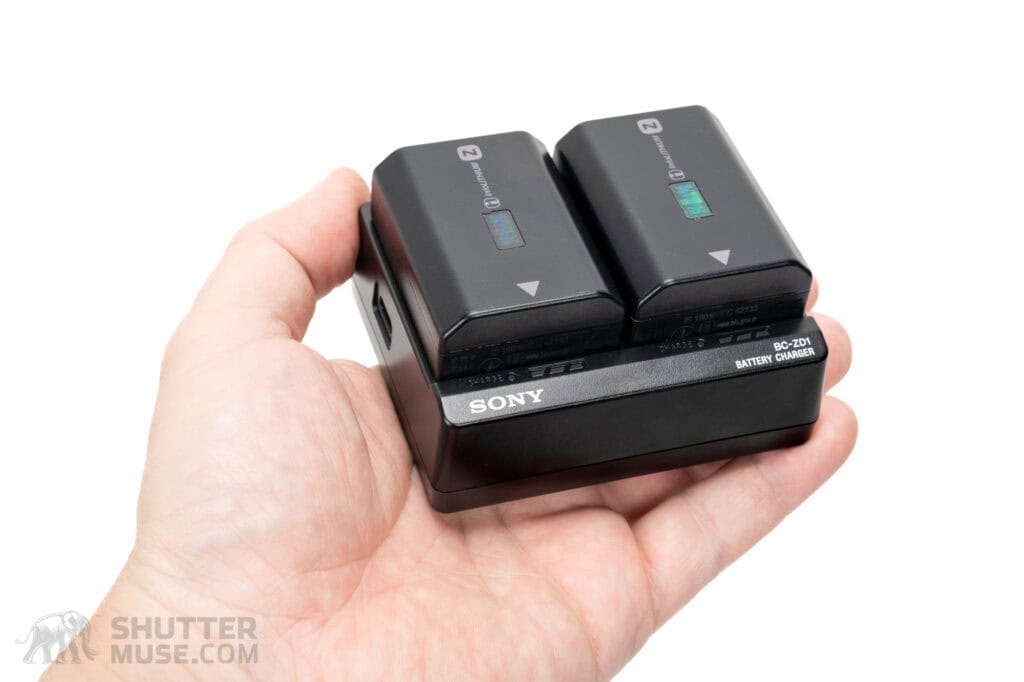
Table of Contents
Sony BC-ZD1 Specifications
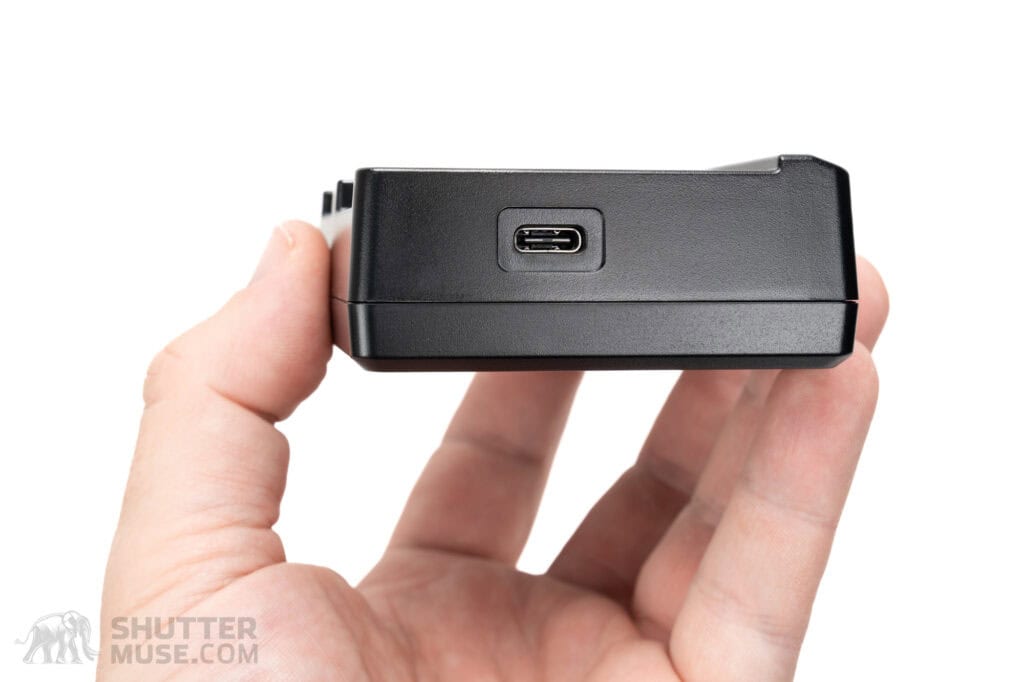
- Number of Battery Bays – 2
- Supported Battery Type – Sony NP-FZ100
- Power Source – USB Power (not included)
- Power Input – USB-C
- Input Specification – 15 V, 2 A
- Output Specification – 8.4 V, 1.6 A x 2
- Dimensions – 3.3 x 2.8 x 1.1″ / 84.5 x 70 x 29.2 mm
- Weight – 5.3 oz / 149 g
- Price at review time – $119.99 (check current price)
Sony’s Charge Time Claims
| Charger | Charge Time (minutes) |
|---|---|
| BC-QZ1 (mains charger) | 150 (claimed) |
| BC-ZD1 (USB-C) with single battery | 155 (claimed) |
| BC-ZD1 (USB-C) with two batteries | 155 (claimed) |
| Battery charged in-camera via USB-C | Not specified |
Before conducting my own real-world charge time tests, I wanted to get a baseline. Digging into the manuals for the BC-QZ1 and the BC-ZD1 chargers reveals Sony’s estimates for NP-FZ100 charge times. According to its testing, Sony says a single NP-FZ100 will charge to 100% in the BC-ZD1 USB-C charger in 155 minutes. They say that two batteries will also take 155 minutes as the charger draws twice the power as long as the USB power supply delivers a minimum of 30W. They also say a single battery will charge to full in the old main-powered BC-QZ1 in 150 minutes. Or roughly 3.3% faster than the USB-C powered dual charger. Sony notes that battery health and room temperature affect charging times, so there may be some slight variation. As the saying goes: Trust but verify. So let’s do that with some testing.

Real-World Charge Time Testing
My Testing Methodology
As noted, battery health and room temperature will affect charge times. My testing was all carried out with one specific NP-FZ100 and conducted in a room measuring 22 degrees Celsius (72F). This may produce results that differ very slightly from your testing; however, the continuity of battery and temperature makes the relative charge time differences as relevant as possible. In-camera charge time tests were conducted using a Sony a9 III. At the time of this review, the a9 III is Sony’s latest camera since the a1 II is not yet shipping.
To test the charge times, I set up a camera pointed at the chargers and an Anker power brick with a screen displaying USB port power output. I’m not going to sit and watch the charger repeatedly for over two hours, so the video recordings allowed me to quickly scrub through the frames to pinpoint the exact moment specific charging percentages and a full charge were reached and view the variations in power draw throughout the charge cycle.
The battery was charged three times in each charger, and an average was taken for the final results. Obviously, for the dual-battery charge time test, a second NP-FZ100 was needed. While the tests were primarily for charge times, I was curious to see the charger’s peak power draw in the USB-C charger to determine the optimal USB power supply to pair with the BC-ZD1.
What Is being Tested?
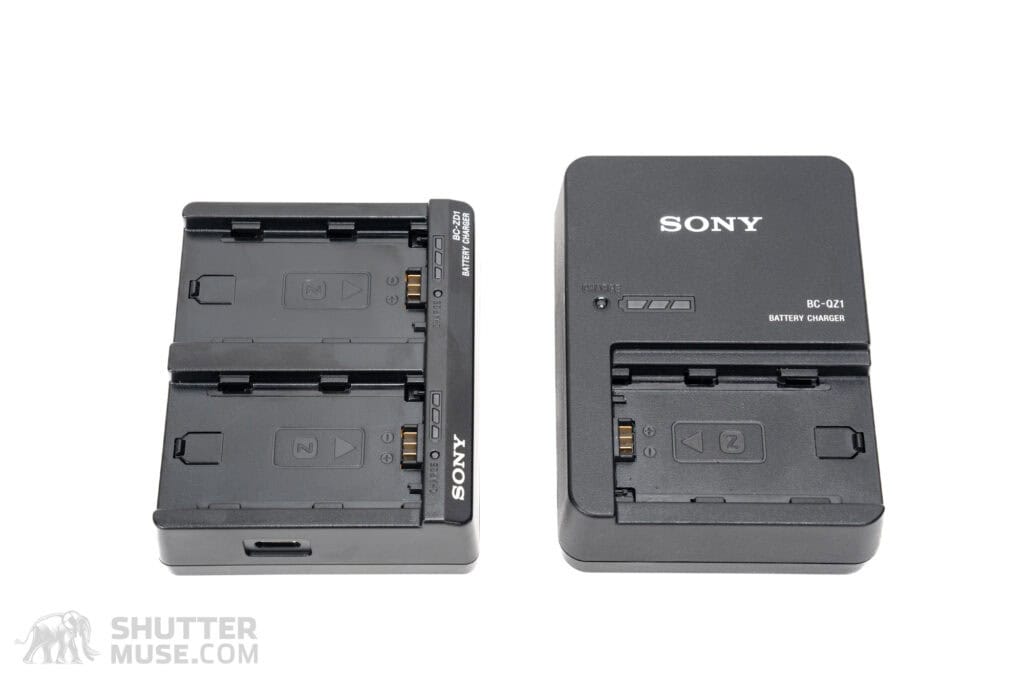
I was curious to know how NP-FZ100 battery charge times differed between the new BC-ZD1 USB-C charger and the old BC-QZ1 mains-powered charger Sony has been selling, or including with some cameras, since 2017. There are obvious benefits to the new USB-C charger in terms of its two-battery capacity and overall size compared to the old charger, but would there be any change to charging times? How would charge time be affected when charging a pair of fully depleted batteries? Furthermore, how does battery charge time in the BC-ZD1 USB-C charger compare to simply charging the battery in the camera using a USB-C cable?
Lithium batteries charge faster at the beginning of their charge and slow dramatically towards the end. I’d never tested a camera battery to see how that played out in the real world, so a visual indication of power draw through the charge cycle would also allow me to map that out and learn something new while also testing Sony’s claims about the new USB-C charger’s maximum power draw.
Charge Time Test Results
| Charger | Charge Time (minutes) |
|---|---|
| BC-QZ1 (mains charger) | 135 |
| BC-ZD1 (USB-C) with single battery | 158 |
| BC-ZD1 (USB-C) with two batteries | 156 |
| Battery charged in-camera via USB-C | 172 |
Charging Profile and Power Draw Over USB-C
I gathered more detailed information about the battery charging profile in the Sony BC-ZD1 USB-C charger using a USB-C power supply that indicates the current power output. With an NP-FZ100 in the BC-ZD1 charger, it started by drawing around 11.3 watts and slowly climbed from there. The first of the charger’s three green lights came on at 24 minutes, indicating the battery was roughly 30% charged.
| Charged Capacity | Charge Time (minutes) |
|---|---|
| 30% | 24 |
| 60% | 47 |
| 90% | 79 |
| 100% | 158 |
At around 47 minutes, the second of the three green bars lit up (60%) on the charger, and at 55 minutes, the charger had seemingly reached its power draw ceiling at 14.98 watts. From there, the power draw slowly began to fall. At the 79-minute mark, the third of the three green bars lit up, indicating the battery was roughly 90% fully charged. However, the power draw had dropped to just 5.3 watts by this point and continued to fall to 0.3 watts. It took a further 79 minutes to get from 90% to 100%.
The speed of this last 10%, essentially doubling the charging time, wasn’t entirely surprising. If you’ve ever sat in an electric car while it charges, you’ll have seen a similar issue. Interestingly, something I’d not picked up before is that the orange charge light on both Sony chargers turns off when the third of the green indicators turns on. At this point, the battery is roughly 90% charged. At first, I wondered why that was, but after my testing, it became clear that Sony had been quite clever with this implementation.
Charging from 0% to 90% takes around 79-80 minutes, but the last 10% to full doubles the charge time. If you’re in a hurry, waiting for the full top-up to 100% is not worth it. You’d be better off throwing another empty battery on the charger, which could reach 10% charge in around 10 minutes or 90% charge in the time it would take your first battery just to get from 90% to 100%.
Knowing this, Sony has given us two things to watch out for on its chargers: When the orange light goes out, you’re at around 90% charge and have had the most efficient portion of the battery charging profile. This easy-to-see visual indicator tells you that you should pull the battery off the charger at that point if you are in any way time-limited and seeking maximum efficiency. If you aren’t time-limited–perhaps you’re charging overnight–you’ll know when the battery has finally reached 100% when all three green lights turn out. Useful stuff.

Result Discussion
Single-Battery Charging – USB vs Mains
This test produced some unexpected results. Sony claimed the old mains-powered BC-QZ1 charger would charge an NP-ZF100 battery 5 minutes faster than the newer USB-C charger, but my testing showed the old charger was, on average, closer to 23 minutes faster (~ 15%). I also saw far more significant charge time variation while using the BC-QZ1 than charging the same battery in the USB-C-powered BC-ZD1, with a spread of between 129 and 142 minutes for a full charge. In contrast, full charge times in the USB-C charger were all within a few minutes of each other, and all within 2% of Sony’s claimed 155 minute charge time.
So, what do we make of this? The variation in charge times seen with the old mains-powered charger and the significant deviation from Sony’s claims with that charger suggests they have tweaked their charging protocols to hit their goals more consistently and accurately. You must clearly understand that all camera manufacturers could charge lithium batteries much faster if they wanted to. However, heat is the enemy of lithium battery longevity. A faster charge time means increased heat, affecting a battery’s long-term health. Consumers would need to replace aging batteries sooner, which is a problem when a replacement costs $80.
All camera battery chargers are designed to balance charging times and lifespan. While some people will undoubtedly be disappointed that the new USB-C charger slightly slows down single-battery charge times compared to the old mains-powered charger, I would guess that the seemingly more consistent results will improve long-term battery health.
Let’s also not forget that Sony now has 7+ years of experience charging the NP-FZ100 in the old charger. I’m sure they’ve learned a thing or two about long-term battery health during that time, and I’m sure the new BC-ZD1 USB-C charger’s circuitry has been carefully designed to read data from the battery and optimize the charge time to be as close to Sony’s goals as possible. In short, this isn’t all about charging speed. There will be a calculated reason for the new BC-ZD1’s charge times.
Dual-Battery Charging

Putting the single-battery charge times aside for a few minutes, it’s the dual-battery charge times that most people should focus on. Very casual photographers do not often own a spare battery for their cameras. They are content with recharging the one in the camera and never burn through that battery in one day. However, the Sony NP-FZ100 battery is only used in cameras aimed at decidedly more shutter-happy people. If you are a casual photographer, it’s unlikely you own an FX, a7, a9, or a1 series Sony camera. Thus, it’s a near certainty that you’ll have more than one battery.
If that is the case, you should be delighted to see, as I am, that the new BC-ZD1 USB-C charger will charge two NP-FZ100 batteries in just a few minutes longer than the old BC-QZ1 mains charger took to charge one battery. If we look closer at the charging profile and the charge percentages reached at different times, we can see that the new USB-C charger will charge two NP-FZ100 batteries to 90% in less time than it takes the old mains-powered charger to get one battery to 100%. All in a smaller, more portable charger than the old single-battery mains charger. For me, this is the biggest takeaway from my testing.
In-Camera USB Charging
A further interesting tidbit from the testing results is that in-camera charging is a reasonably fast option if a) you only have one battery that needs charging or b) you have three batteries that need charging. If you plug the camera into a USB power adapter and stick two more spares in the BC-ZD1 USB-C charger, the battery in the camera will reach a full charge roughly 20 minutes after the two in the USD-C charger. The power draw maxed out at 14W when the battery was charged in the camera over USB-C.
Overall, I would say the slightly slower USB-C charge times in the BC-ZD1, compared to the mains-powered charger times, are easily offset by the significantly improved portability of a two-battery charging solution and the universal compatibility of a USB-C-powered solution, which allows the charger to be used on the go with a USB battery bank or in-vehicle charging port.
Recommended USB Charger, Cable, and Battery Bank for the Sony BC-ZD1
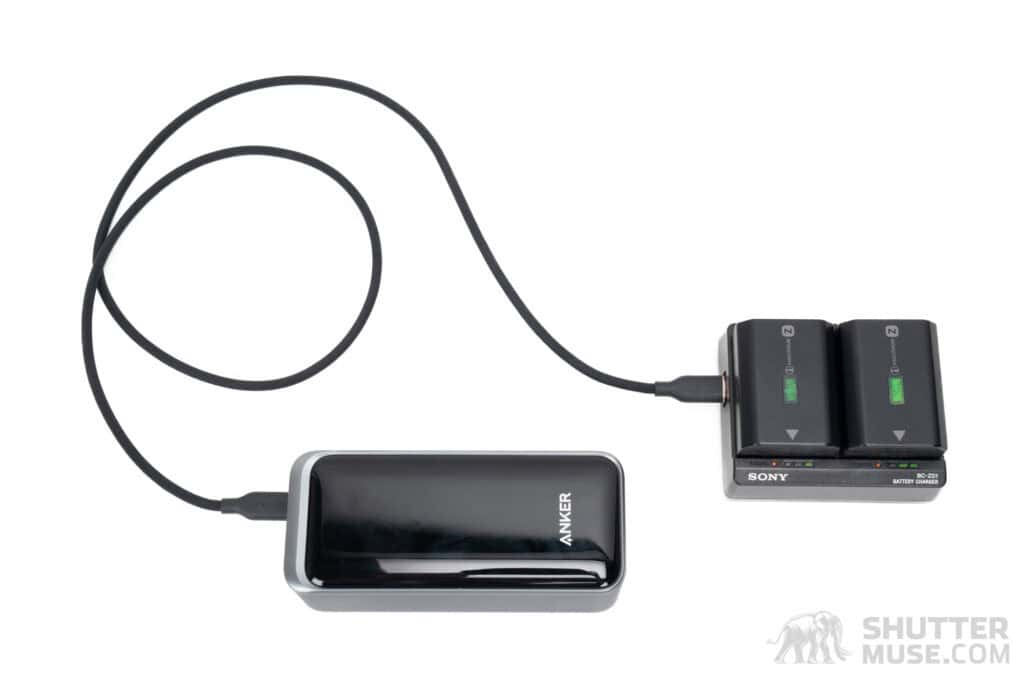
My tests confirmed that when charging a single battery in the BC-ZD1, the charger doesn’t draw more than 15 watts. Sony claims single-battery charging can reach 18W, but I never saw that in my tests. Charging two batteries simultaneously doubles the power draw but never exceeds 30 watts. This means that while you can use any USB-C charger with the Power Delivery (PD) protocol, anything delivering less than around 30W will not charge the batteries as fast as they could be charged, and anything delivering more than 30W is unnecessary. You can, for example, use your 100W Apple MacBook charger, but the Sony charger will still draw up to around 15W for one battery or 30W for two batteries, so there is no benefit to this other than the fact that you don’t have to go out and buy another charger.

It would be wrong to assume that since the charger draws at most 30W, a 30W-rated charger is the solution. Life is never that simple! Electrical inefficiencies mean a 30W charger usually outputs a little less than 30W to the connected device, often 25-27W. To ensure the absolute maximum charging speed, your best bet is to use (or buy) something with a slightly higher power output.
If you buy a USB charger specifically for your Sony BC-ZD1, I recommend the Anker 511 30W Nano charger for full-speed single-battery and very near-full-speed dual-battery charging. It is just 1.12 inches thick, weighs 0.088 lb, and costs around $20. Alternatively, this Anker 45W charger will ensure the fastest charge speed for a similar price but at the expense of a slightly bigger form factor. Pair either of these chargers with Anker’s best USB-C cable, the 3ft Flow cable. These tremendous compact chargers and cable combinations pair perfectly with the small size of the BC-ZD1.
If you want to charge your Sony camera batteries off a portable USB-C power bank while on the road, all the same logic applies. Any USB battery bank with a USB-C PD port will work. Still, anything less than a 30W output will be slower, and anything much more than 30W is only necessary if you want to simultaneously charge multiple other devices off the battery bank.
I recommend this cost-effective 10,000mAh Anker battery pack with a 30W output as a good starting point for single battery charging with the Sony BC-ZD1 charger. My testing of this 10,000mAh battery pack showed that 65% of the battery bank’s power is consumed while charging one Sony NP-FZ100 battery. This leaves you another 35% for a top-up later, or you could charge two NP-FZ100 batteries to around 75%.
In an ideal world, a battery bank with a 15,000mAh capacity seems perfect for recharging a pair of NP-FZ100 batteries. Unfortunately, battery bank capacities increase in predictable steps, and the next step up is 20,000mAh. I like this Anker 20,000mAh battery bank for recharging multiple NP-FZ100 batteries in the BC-ZD1 charger. You will get around three full recharges of an NP-FZ100 battery from this battery at a full 30W. Or, perhaps more likely for many people, it’ll give you enough juice for two camera battery recharges, with plenty left over to top up other daily-use devices such as your phone, headphones, action cameras or even smaller drones.
Interestingly, as an emergency solution, you could also use the bidirectional charging function of any iPhone with a USB-C port to charge NP-FZ100 batteries in the BC-ZD1 charger. This is similar to how I have detailed charging a camera directly via an iPhone. This is a viable solution if you just need a few more minutes of shooting from your camera batteries.
Conclusion
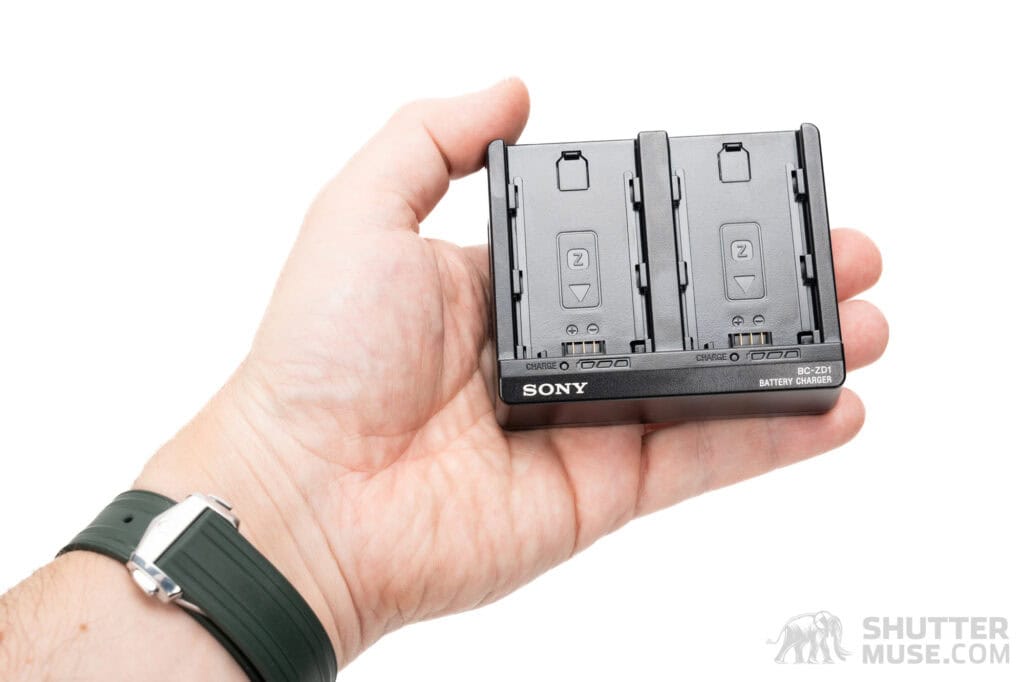
Put simply, the BC-ZD1 USB-C charger should be in every Sony photographer’s kit, and it’s a concept I have been waiting for a camera manufacturer to adopt for some time. If you have bought a Sony Alpha camera that doesn’t come with a battery charger, such as the a7 IV, the FX30, FX3, or any of the APS-C models that use the NP-FZ100 battery, it’s a no-brainer to choose the new BC-ZD1 USB-C charger over the outdated BC-QZ1 single-battery mains charger. Even if you bought a camera that included the old BC-QZ1 mains-powered charger, such as the a1, a9 III, a7R V, or earlier models from the past several years, it’s worth standing those down from service and picking up the new BC-ZD1 instead if you have more than one NP-FZ100 battery in your kit.
The USB-C charger is far more compact, can charge two batteries to 90% in the same time it takes the old mains charger to charge a single battery to 100% and can be easily plugged into a portable USB battery bank or charged from a USB-C 12v car adapter. The better build quality and dual-battery charging feature justifies the $20 price premium over the old mains charger. The downside of the USB-C charger is slightly slower single-battery charging times. However, most people in the real world are unlikely to notice the difference, and again, the compact size and dual-battery capacity are a worthwhile tradeoff.
The Sony a1 II is the first camera to include the BC-ZD1 in the box, though professional shooters should pick up a second one of these chargers, as I have. Using more than two batteries daily is easy, but I’ll rarely get through more than four. A pair of these chargers in my kit is barely bulkier than a single one of the old mains-powered chargers but will charge four batteries to 100% in roughly 150 minutes or all of them to 90% in just 80 minutes. Anecdotally, as someone who regularly shoots with different gear from Sony, Nikon, Canon, Fujifilm, etc., this is the best 1st-party camera battery charger from anyone so far. Great job, Sony.
Where to Buy
Using my links for your purchases is always appreciated. The Sony BC-ZD1 USB-C battery charger is available from the links below, along with my recommended USB chargers and cables.
- Sony BC-ZD1 USB-C Charger – B&H Photo / Amazon / Adorama / WEX (UK)
- Sony BC-QZ1 Mains Charger – B&H Photo / Amazon / Adorama / WEX (UK) / KEH (used)
- Anker 511 Nano 3 30W Charger (recommended) – Anker / Amazon
- Anker Flow 3ft USB-C Cable 100W (recommended) – Anker / Amazon
- Anker 10,000mAh 30W Nano Power Bank (recommended) – Anker / Amazon
- Anker 20,000mAh 100W Prime Power Bank (recommended) – Anker / Amazon


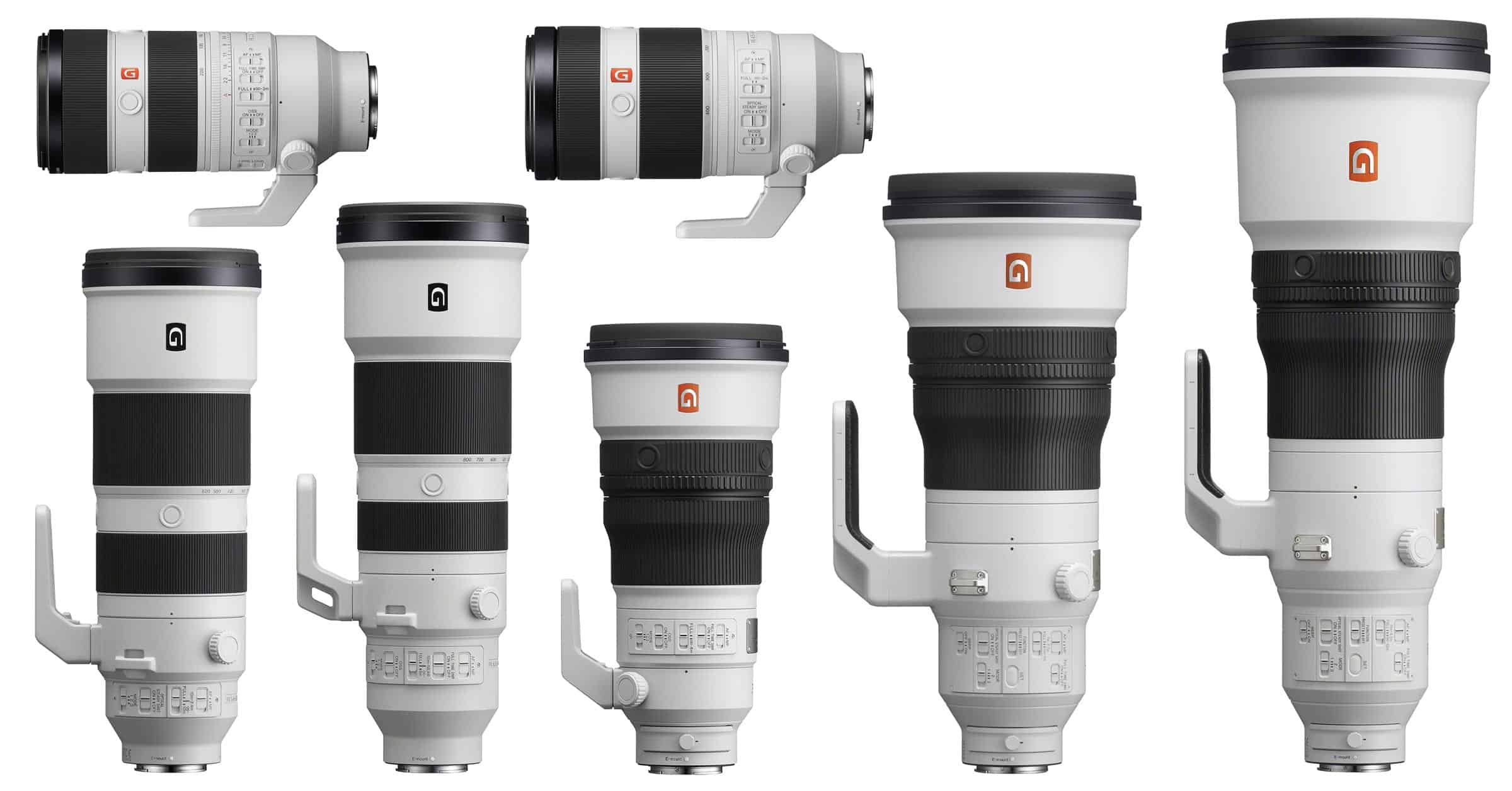

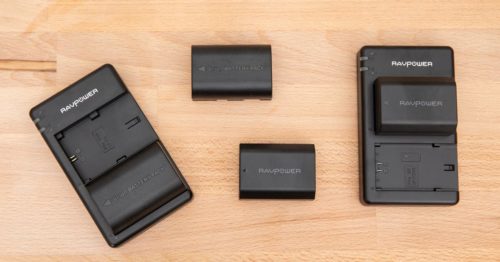
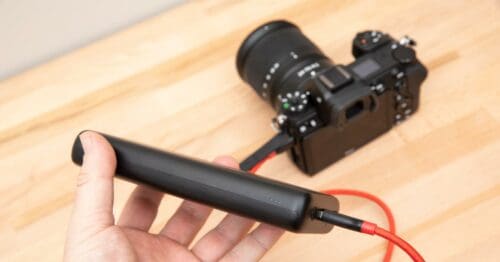


Good that Sony finally produced a dual charger, but I think I would still prefer the ISDT NP2 which has a very useful display to give accurate charging data, and also you can select normal or fast charging speeds….